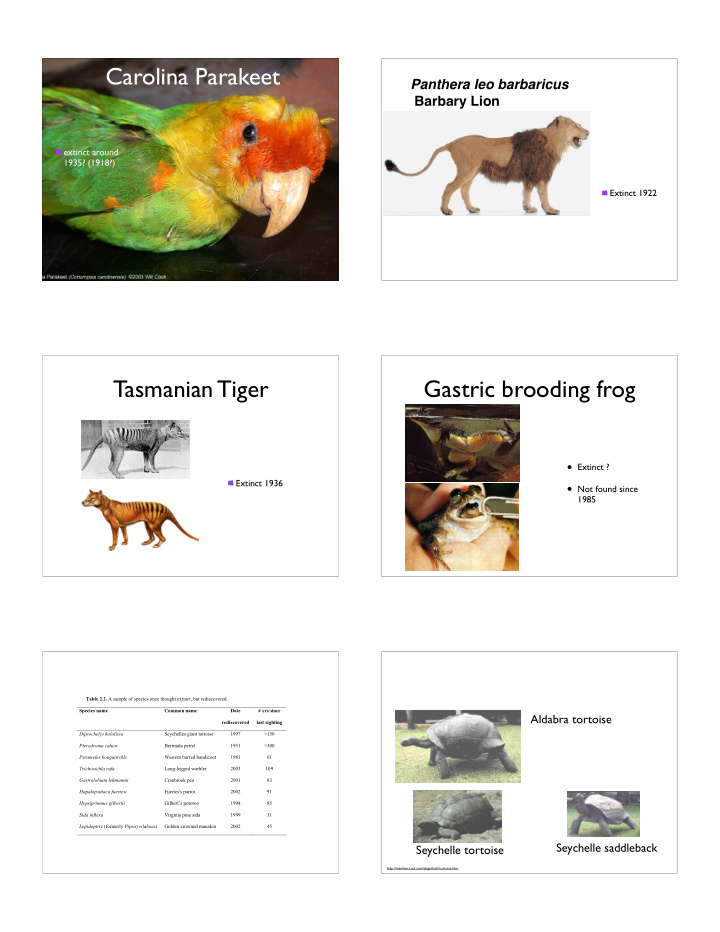



Carolina Parakeet Panthera leo barbaricus Barbary Lion extinct around 1935? (1918?) Extinct 1922 Tasmanian Tiger Gastric brooding frog • Extinct ? Extinct 1936 • Not found since 1985 Table 2.2. A sample of species once thought extinct, but rediscovered. Species name Common name Date # yrs since Aldabra tortoise rediscovered last sighting Dipsochelys hololissa Seychelles giant tortoise 1997 >150 Pterodroma cahow Bermuda petrel 1951 >300 Perameles bougainville Western barred bandicoot 1983 61 Trichocichla rufa Long-legged warbler 2003 109 Gastrolobium lehmannii Cranbrook pea 2001 83 Hapalopsittaca fuertesi Fuertes's parrot 2002 91 Hypsiprimnus gilbertii Gilbert’s potoroo 1994 85 Sida inflexa Virginia pine sida 1999 31 Lepidoptrix (formerly Pipra ) vilaboasi Golden crowned manakin 2002 45 Seychelle saddleback Seychelle tortoise http://members.aol.com/jstgerlach/tortoise.htm
Measuring Current Extinctions ong the Direct observation are difficult Indirect observation: species - area relationship Species-Area relationship Species-Area relationship S = c × A z S = c × A z c is a taxon specific constant c is a taxon specific constant z is the extinction coefficient z is estimated using the slope is in the range 0.1 to 0.3 Number log(Number of species S of species S) Area A log(Area A) Mac Arthur and Wilson (1967): the theory of island biogeography Fig 4.5 Small mammals in forest granivores all small mammals r 2 = proportion of variation explained
Estimating extinction rates Estimating how many species go extinct S now A z now = Log(Number Log(Number S original A z original of species S) of species S) A z now S now = S original Log(Area A) Log(Area A) A z original S now cA z now = using S original cA z original z=.15 (this is arbitrary) deforestation = 1.8% per year (Anow / Aoriginal = 98.2/100) 10 million species (Soriginal) Snow = 9,973,000 Difference between Snow and Soriginal = 27,000 species per year Causes of extinction? Causes of endangerment 100 Percent of species affected 88 90 80 70 60 46 50 40 30 20 14 20 10 2 0 Overharvest degradation destruction species Pollution Disease Exotic Habitat and Causes of extinction Causes of endangerment 100 Percent of species affected 88 90 80 70 60 46 50 40 Habitat destruction 30 20 14 20 10 2 habitat loss (less area = fewer species) 0 Overharvest degradation destruction species Pollution Disease Exotic Habitat and
Causes of extinction Habitat destruction habitat loss (less area = fewer species) habitat fragmentation Fringed prairie orchid Causes of extinction Fig 55.6 Forest cover of Cadiz Township in Wisconsin Habitat destruction habitat loss (less area = fewer species) habitat fragmentation Edge effects Fragmentation Fig 4.5 Small mammals in forest granivores all small mammals r 2 = proportion of variation explained
Causes of extinction Habitat destruction Habitat loss (less area = fewer species) Habitat fragmentation Edge effects Isolation Exotic species Causes of endangerment 100 Percent of species affected 88 90 80 70 Exotic species: species introduced to regions outside of their 60 native range 46 50 40 30 Invasive species: an exotic species with strongly increasing 20 14 20 populations (and most often detrimental effect on the 10 2 native species or habitats) 0 Overharvest degradation destruction species Pollution Disease Exotic Habitat and Exotic species Invasive species Brown tree snake Kudzu Zebra mussel Introduced to Guam, Introduced to the South- Introduced through boats into predated and eradicated East USA for their edible Great Lakes, clogging up water all native endemic bird leaves and pretty flowers. intakes, removing food more species Overgrowing forests, effective out of water column changing native habitats than natives.
Pollution Causes of endangerment Point sources Non-Point sources 100 Percent of species affected 88 90 80 70 60 46 50 40 30 20 14 20 10 2 0 Overharvest degradation destruction species Pollution Disease Exotic Habitat and Pollution Pollution Air Water Global warming Acid rain Ozone depletion, smog, .... Pollution Heavy metal Water Water Body Species Women of All Other Individuals childbearing age, (# of meals)* Toxins young children Lake Iamonia Largemouth Bass One per month One per week Nutrients eutrophic vs oligotrophic Lake Jackson Black Crappie, One per month One per week Bluegill, Largemouth Bass PRESS RELEASE, JULY 26, 2004 Lake Miccosukee Bluegill Two per week Two per week LOUISIANA UNIVERSITIES MARINE CONSORTIUM Largemouth Bass One per month One per week AVERAGE SIZE "DEAD ZONE" IN ANYTHING BUT AN AVERAGE YEAR The coast-wide extent of the Louisiana "dead zone" mapped this week is slightly larger than average at 15,040 km 2 (5,800 square miles). The long-term Lake Munson Black Crappie, Redear One per month One per week average since mapping began in 1985 is 13,000 km 2 (5,000 square miles). The river flow and the offshore conditions prior to the mapping cruise were Sunfish anything but normal and were more reminiscent of the Great Mississippi River Flood of 1993. The river in 2004 peaked in discharge several times in January February, March and May, followed by a prolonged above average flow that persisted from June into July, as in 1993. Moore Lake Largemouth Bass One per month One per week http://www.myfloridaeh.com/community/fishconsumptionadvisories/FWFGuide.htm
Exploitation Incidental Exploitation Commercial Bycatch: albatross, whales, .... Predator control in parks Recreation Pets Recreational Diseases Causes of extinction (Atelopus zeteki) Habitat destruction Chytrid, a fungus, is believed to be one of Exotic species the sources for Pollution amphibian decline Exploitation Diseases www.clemetzoo.com/conservation/project_golden_frog.asp
Recommend
More recommend